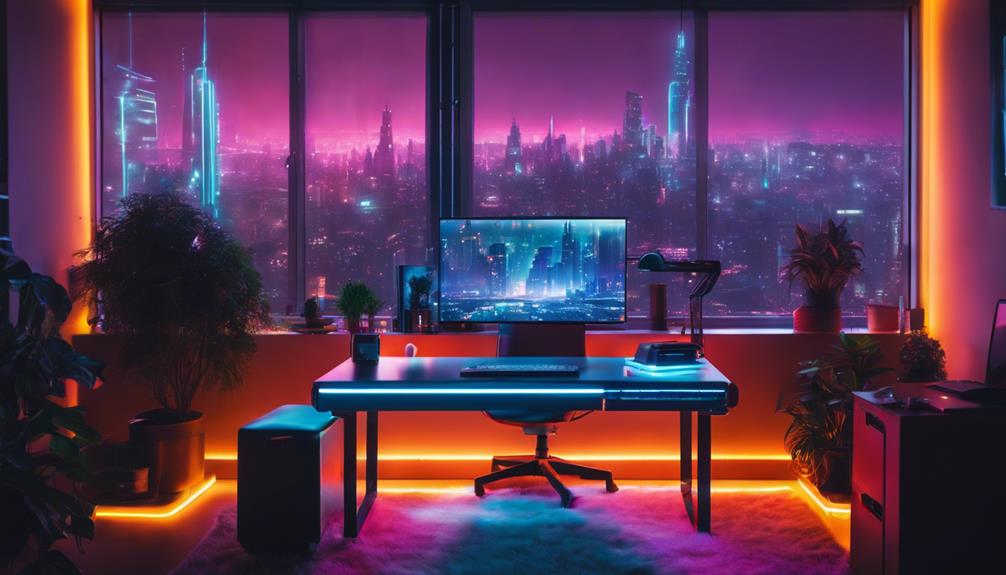You can enhance your efficiency by turning your home office into a space inspired by cyberpunk aesthetics. Begin by implementing a dark color scheme complemented by neon lights and modern materials such as glass and metal. Opt for a futuristic desk equipped with advanced technology, such as wireless charging and USB ports. Integrate adjustable lighting using dynamic LED strips to elevate the atmosphere and spark creativity. Add bold wall art and tactile decorations to establish an engaging environment. Complete the look with flooring options that match your personal style, such as metallic epoxy or dark concrete. Keep discovering more ideas for creating your perfect cyberpunk workspace!
Key Elements

To create a truly immersive cyberpunk home office, you need to focus on the color scheme, materials, and textures.
Think bold neon hues paired with dark surfaces to set the mood.
Incorporating varied textures will enhance the futuristic vibe while ensuring your workspace feels inviting and dynamic.
Color Scheme
A cyberpunk-inspired color scheme combines dark, moody tones with vibrant neon accents to create a visually striking workspace. Focus on deep blues, purples, and blacks as your base colors. These hues evoke calmness and encourage concentration, setting a perfect tone for productivity.
Then, add neon lights in hot pink, electric blue, or bright green to inject energy and excitement into your office. These bright colors not only enhance your workspace feel but also stimulate creativity.
Incorporating metallic finishes like chrome or brushed steel can amplify the futuristic vibe, reflecting the high-tech elements typical of cyberpunk aesthetics. Use LED strips or neon signs to establish dynamic lighting effects that accentuate your chosen color scheme, creating an immersive environment.
To enhance cohesion, consider wall art featuring geometric patterns or urban landscapes that align with your color palette. This not only reinforces the theme but also contributes to that edgy, dystopian ambiance.
Materials
Choosing materials like glass and metal instantly elevates your home office with the sleek, high-tech aesthetic that defines cyberpunk design. These materials not only reflect modernity but also enhance the futuristic vibe of your workspace. When selecting desk accessories, opt for tech-integrated pieces that embody this aesthetic while serving functional purposes. Think minimalist designs with sharp lines and metallic finishes.
Incorporating neon lighting fixtures can transform your office into an immersive environment, boosting creativity and productivity. The glow from these lights can accentuate your chosen materials, creating a striking contrast that energizes the space.
Don't forget to integrate biophilic elements into your design. Adding strategically placed plants, sourced from platforms like Quixel, not only softens the industrial feel but also greatly improves air quality. This balance between modern materials and natural elements fosters a more inviting atmosphere, allowing you to thrive.
Lastly, consider bold color schemes that complement your materials. Dark tones paired with bright neons will evoke the signature cyberpunk style, stimulating motivation and focus in your workspace. Your choice of materials sets the tone for productivity in your cyberpunk-inspired home office.
Textures
Incorporating a variety of textures, like sleek glass and rugged metal, creates dynamic visual contrasts that capture the essence of a cyberpunk-inspired home office. This blend not only enhances visual appeal but also stimulates your productivity and creativity.
You can use Quixel-sourced plant textures to introduce organic elements that soften the sharp edges of your workspace, striking a balance between nature and technology.
Adding assets from the Unreal Marketplace, such as textured books and surfaces, enriches your home office with layers of detail that evoke a futuristic yet lived-in atmosphere. Experiment with matte and glossy finishes to highlight that high-tech, gritty vibe typical of cyberpunk environments. The interplay of different textures can maintain your interest and keep your mind engaged.
Don't shy away from tactile materials like leather, concrete, and neon-lit elements. These choices can elevate your workspace, immersing you in a cyberpunk setting that fuels your creativity.
Essential Fixtures and Furniture

To create a true cyberpunk-inspired home office, you'll want to focus on essential fixtures and furniture that enhance both style and functionality.
Think neon LED strip lights that set the mood, a futuristic desk with integrated tech for seamless productivity, and a holographic projection display unit to elevate your workspace.
These elements won't only reflect your unique aesthetic but also optimize your work experience.
Neon LED Strip Lights
Neon LED strip lights transform your home office into a vibrant cyberpunk haven, providing customizable ambient lighting that enhances both style and mood. These lights are essential for creating an immersive workspace that captures the essence of cyberpunk aesthetics. You can easily install them along walls, furniture edges, or shelving, allowing for versatile designs that fit your unique vision.
With RGB color options, you can select specific hues that resonate with your personal style, whether you prefer striking blues, pinks, or other vivid shades. Smart LED strips can also be controlled via smartphone apps or voice assistants, giving you the convenience to adjust brightness and colors without losing your focus.
To elevate your office further, incorporate these neon LED strip lights with retro-futuristic artwork and ergonomic furniture, creating a cohesive atmosphere that sparks creativity and boosts productivity. The combination of customizable ambient lighting and stylish decor brings your cyberpunk-inspired home office to life, making it a space where you'll thrive.
Embrace the glow and let your workspace reflect the dynamic world of cyberpunk, enhancing both your workflow and your environment.
Futuristic Desk With Integrated Tech
A futuristic desk equipped with integrated technology transforms your home office into a hub of efficiency and creativity. Look for a design that features built-in wireless charging pads, USB ports, and smart lighting, making it easier to stay connected and focused. One of the best options is a standing desk that adjusts electronically, allowing you to switch between sitting and standing throughout the day, promoting better health and productivity.
To streamline your workspace, consider incorporating tech-enhanced accessories like a monitor with adjustable height and a built-in webcam. These features not only improve your video call quality but also optimize your overall workspace layout.
When selecting a futuristic desk, aim for sleek, minimalist designs with reflective surfaces and neon accents to align with the cyberpunk aesthetic. This creates a visually stimulating environment that sparks creativity.
Don't forget about comfort—invest in an ergonomic chair with advanced features like memory foam support and customizable settings. This way, you can guarantee comfort during those extended work sessions while benefiting from the integrated technology in your cyberpunk home office.
With the right desk and accessories, you'll be ready to tackle any project with style and efficiency.
Holographic Projection Display Unit
Holographic projection display units transform your cyberpunk home office into an immersive workspace where 3D visuals enhance productivity and creativity. These cutting-edge holographic displays utilize advanced projection technology to bring your ideas to life, allowing you to visualize complex data and designs in an alluring manner.
Imagine being able to manipulate virtual objects and layouts right in front of you, making your workflow more intuitive and engaging. With customizable interfaces, you can arrange your virtual workspace according to your preferences, creating an environment that caters to your productivity needs.
Whether you're juggling multiple documents or brainstorming new concepts, a holographic display lets you multitask effortlessly, displaying applications in three-dimensional space.
Incorporating a holographic projection unit into your setup aligns perfectly with the cyberpunk theme, merging futuristic technology with your daily tasks. This integration not only enhances your aesthetic but also fosters a unique and engaging work environment.
Lighting Ideas

When it comes to lighting your cyberpunk home office, think beyond traditional options.
Consider incorporating glowing fiber optic ceiling panels and neon backlit wall panels to create a futuristic vibe.
Dynamic LED color-changing panels and laser-cut geometric light fixtures can add a unique touch while enhancing your workspace's overall aesthetic.
Glowing Fiber Optic Ceiling Panels
Glowing fiber optic ceiling panels transform your home office into a vibrant, futuristic workspace, casting an enchanting neon ambiance that fuels creativity and focus.
These panels create stunning ambient lighting, simulating the characteristic glow of cyberpunk aesthetics. Utilizing numerous tiny fibers, they transmit light in customizable colors, allowing you to enhance your mood and boost productivity.
You can easily integrate fiber optic panels with smart lighting systems, giving you the power to adjust brightness and color temperature based on your preferences or the time of day. This flexibility guarantees you always have the right lighting for your tasks. Plus, with their low energy consumption, these panels offer an eco-friendly option that won't notably impact your electricity bills.
One of the most notable advantages of glowing fiber optic ceiling panels is their ability to reduce eye strain. They provide soft, diffused light, which is essential for long hours of work in your home office.
Neon Backlit Wall Panels
Neon backlit wall panels instantly elevate your home office's ambiance, infusing it with the vivid colors and dynamic energy characteristic of cyberpunk design.
With vibrant hues like electric blue, hot pink, and bright green, these panels create a striking visual effect that not only enhances aesthetics but also boosts your productivity. You can customize them using LED strips, allowing you to change colors and brightness levels according to your mood or task at hand.
When you install neon backlit wall panels behind furniture or artwork, they add depth and dimension to your workspace, making it feel more immersive and engaging.
This immersive environment can stimulate your creativity, providing a unique backdrop for your work sessions.
Dynamic LED Color-Changing Panels
Building on the vibrant energy of neon backlit wall panels, dynamic LED color-changing panels offer an innovative way to tailor your home office lighting to suit your workflow and mood.
With the ability to program these panels to shift colors throughout the day, you can maintain energy levels and focus during work hours. This dynamic lighting adapts to your needs, enhancing productivity by utilizing color psychology; blue tones promote calm and concentration, while warmer hues can inspire creativity and energy.
You'll love the customizable settings that allow you to create specific lighting scenes, perfectly aligning with the immersive cyberpunk aesthetic. Many panels also feature smart technology integration, so you can control them through mobile apps or voice commands, making adjustments without breaking your flow.
Furthermore, the geometric designs of LED panels not only add a visually striking element to your home office but also provide functional lighting that reduces eye strain during long working sessions.
Laser-Cut Geometric Light Fixtures
Laser-cut geometric light fixtures bring a striking visual element to your cyberpunk-inspired home office, enhancing the space with intricate designs that reflect futuristic themes.
These fixtures often utilize LED technology, providing vibrant neon-like lighting while promoting energy efficiency and longevity compared to traditional bulbs. The precise cuts create unique shadows and patterns on your walls, contributing to the immersive atmosphere typical of cyberpunk environments.
You can customize these fixtures to match your color schemes, making them versatile additions to your workspace. Whether you want a pop of color or a more subdued tone, there's a design that fits your vision.
Additionally, incorporating adjustable lighting allows you to control brightness and ambiance, seamlessly shifting between focused work modes and more relaxed settings.
Decorative Elements

To truly embrace the cyberpunk vibe in your home office, consider incorporating striking wall art that captures the essence of this futuristic genre.
A holographic cityscape centerpiece can serve as a conversation starter, while retro-futuristic tabletop sculptures add character and intrigue to your workspace.
These decorative elements not only enhance your environment but also inspire your creativity and productivity.
Cyberpunk-Themed Wall Art
Transform your home office into a vibrant cyberpunk oasis by incorporating neon lights and retro-futuristic artwork that captures the essence of synthwave aesthetics.
Start with bold cyberpunk-themed wall art, like striking prints of dystopian landscapes or iconic cityscapes. These pieces not only serve as eye-catching focal points but also inspire creativity and productivity.
To add a personal touch, consider featuring artwork inspired by your favorite cyberpunk media, whether it's a classic film or a beloved video game. Mixing different styles can enhance your space, so explore design ideas that incorporate both framed art and three-dimensional elements, such as illuminated shelves or unique sculptures.
Don't forget about lighting! Utilizing LED backlighting behind your wall art creates dynamic effects that contribute to the overall ambiance of your office. This not only enhances the aesthetic appeal but also provides functional illumination as you work.
Ultimately, your cyberpunk-themed wall art should reflect your personality while immersing you in a world of creativity and inspiration, making your home office a truly engaging space.
Holographic Cityscape Table Centerpiece
A holographic cityscape table centerpiece consistently draws attention, enhancing your home office with its futuristic charm and vibrant colors. This striking piece not only serves as an eye-catching focal point but also immerses your workspace in an enthralling cyberpunk aesthetic. By utilizing 3D printing technology, you can create intricate and customizable holographic models tailored to your style.
Incorporating LED lights within the holographic centerpiece simulates a neon glow, amplifying the cyberpunk vibe. The use of transparent materials, like acrylic or glass, further enhances the holographic effect, adding depth and dimension to your design. Imagine the mesmerizing interplay of light and shadow as the centerpiece transforms your workspace into a dynamic environment.
For an even more engaging experience, consider adding interactive elements such as motion sensors that trigger lighting changes. This feature makes the centerpiece not just a decorative item but a living part of your office, responding to your movements and creating an atmosphere that inspires productivity.
With a holographic centerpiece, your home office becomes a true reflection of your creativity and love for futuristic design.
Retro-Futuristic Tabletop Sculptures
Embracing retro-futuristic tabletop sculptures can instantly energize your home office with bold geometric shapes and vibrant colors that reflect an enchanting blend of past and future aesthetics.
These decorative elements add a unique flair to your workspace, enhancing your environment and boosting your productivity.
Often crafted from polished metals and acrylics, these sculptures introduce a sleek, modern touch that aligns perfectly with the cyberpunk theme.
Their designs evoke nostalgia for mid-20th century styles while incorporating futuristic themes, turning them into striking conversation starters that inspire creativity.
Many artists use LED lighting techniques in retro-futuristic sculptures, capturing the neon-drenched ambiance that defines cyberpunk aesthetics.
This lighting not only enhances the visual impact but also creates a dynamic atmosphere conducive to focus and inspiration.
Flooring

When it comes to flooring for your cyberpunk-inspired home office, you've got some striking options.
Consider metallic epoxy resin for a sleek, futuristic look, or dark concrete with LED inlays to create that neon glow.
Recycled rubber flooring tiles also offer durability and a unique texture, perfect for capturing the edgy vibe of cyberpunk design.
Metallic Epoxy Resin Flooring
Metallic epoxy resin flooring transforms your home office into a futuristic workspace with its seamless, glossy finish and striking design. This type of flooring not only enhances the overall aesthetic but also provides a durable foundation that can withstand the rigors of a busy work environment. It's resistant to stains, chemicals, and impacts, making it ideal for high-traffic areas.
One of the standout features of metallic epoxy resin flooring is its customization options. You can choose from a wide array of colors and metallic finishes, allowing you to create a unique look that aligns perfectly with your cyberpunk theme. Think vibrant neon colors that pop against sleek furniture, setting the perfect scene for productivity.
Another advantage is its low maintenance requirement. Regular sweeping and occasional mopping are all it takes to keep your flooring looking pristine. This practicality means you can focus more on your work and less on upkeep.
Dark Concrete With LED Inlays
How can dark concrete flooring with LED inlays elevate your home office into a striking cyberpunk haven? This flooring option not only enhances the aesthetic but also provides a modern, sleek foundation for your workspace.
Dark concrete is incredibly durable and low maintenance, making it perfect for high-traffic areas where you spend long hours working.
The integration of LED inlays allows you to customize the lighting, adapting the ambiance to match your mood or the time of day. This flexibility can greatly boost your productivity, as different lighting can influence your focus and creativity.
The stark contrast between the dark concrete and vibrant LED lights creates an inspiring environment that encourages deep work and innovative thinking.
Recycled Rubber Flooring Tiles
Recycled rubber flooring tiles transform your home office into an eco-friendly workspace that balances durability with style. These tiles are perfect for high-traffic areas, offering resilience that withstands the demands of your daily grind. Their excellent noise cancellation properties create a quieter environment, reducing distractions from footsteps and equipment sounds, which boosts your productivity.
Safety is another key benefit of recycled rubber flooring. The non-slip surface guarantees you can move around your office confidently, whether you're shifting between workstations or grabbing supplies. Plus, maintenance is a breeze—just clean them with soap and water, keeping your workspace hygienic without the hassle of complicated upkeep.
One of the most enticing features of recycled rubber flooring is the variety of customized colors and textures available. You can easily incorporate vibrant neon hues or futuristic patterns that align perfectly with your cyberpunk aesthetic.
This not only adds a unique flair to your office but also allows you to express your personality through your workspace design. With these tiles, you're not just creating a home office; you're establishing a productive hub that's stylish and sustainable.
How Can Cyberpunk Design Elements Enhance Creativity in a Home Office Setting?
Incorporating afrofuturism home office design can elevate creativity at home. The fusion of futuristic and traditional African elements brings a unique aesthetic to the workspace, stimulating imagination and innovation. Bold colors, geometric patterns, and innovative furniture can inspire creative thinking and boost productivity in a home office setting.
Conclusion
By blending sleek, futuristic designs with functional elements, you can create a cyberpunk-inspired home office that boosts your productivity and sparks creativity.
Embrace bold colors, innovative lighting, and unique furnishings to bring the aesthetic to life.
Remember to personalize your space with decorative touches that resonate with you.
With these elements in place, you'll have a workspace that not only enhances your efficiency but also immerses you in a fascinating, tech-savvy environment.









